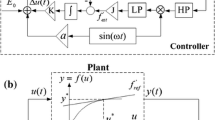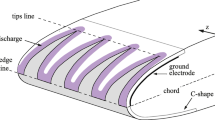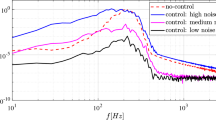Abstract
Closed-loop flow control is aimed at altering a natural flow state into a more desirable state, which is chosen depending on control objectives. The control input is usually an electric signal, which has to be converted to a physical quantity by means of an actuator. A new and original technology using non-thermal surface plasmas has witnessed a significant growth in interest in recent years, as they: have no moving parts; exhibit an extremely fast time-response; are characterised by low mass and low input power. These surface dielectric barrier discharge (DBD) actuators are used to accelerate the near-wall flow, thus modifying the velocity profile within the boundary layer. In this paper, we focus on the robust feedback control of the flow separation using plasma actuators. Our objective is to solve the problem of directly controlling the unsteady flow separation using real-time velocity measurements, which are available in realistic applications. We propose this flow separation problem as a practical application of the new theoretical results in Marino and Tomei, Automatica, 60(8):2213–2218, 2015, [4]. The aim of this paper is to show how, despite the high complexity of the system, a simple robust output regulator is sufficient to effectively suppress the flow separation along an aerofoil, using two actuator/sensor pairs. Accurate two-dimensional (laminar flow) and three-dimensional (turbulent flow) numerical simulations of incompressible flows on a NACA0012 at Reynolds \(Re=20{,}000\) are performed in order to illustrate the effectiveness of the proposed approach. In the two-dimensional case a robust, fast flow reattachment is achieved, along with both stabilisation and increase/reduction of the lift/drag, respectively. The control system shows good dynamic performances, as the angle of attack is varied. For the three-dimensional test, a Large Eddy Simulation (LES) approach has been chosen for the modelling of the turbulence dynamics, whereas the eddy viscosity is calculated according to the well established classical Smagorinsky model.
Access this chapter
Tax calculation will be finalised at checkout
Purchases are for personal use only
Similar content being viewed by others
References
Broglia, R. Zaghi, S. Muscari, R., Salvadore, F.: Enabling hydrodynamics solver for efficient parallel simulations. In: Proceedings International Conference on High Performance Computing & Simulation (HPCS), pp. 803–810. Bologna, Italy (2014)
Broglia, R., Choi, K.-S., Houston, P., Pasquale, L., Zanchetta, P.: Output feedback control of flow separation over an aerofoil using plasma actuators. Int. J. Numer. Anal. Model. 15(6), 864–883. ISSN 1705–5105 (2018)
Di Mascio, A., Broglia, R., Muscari, R.: Prediction of hydrodynamic coefficients of ship hulls by high-order Godunov-type methods. J. Marine Sci. Tech. 14, 19–29 (2009)
Marino, R., Tomei, P.: Output regulation for unknown stable linear systems. Automatica 60(8), 2213–2218 (2015)
Pasquale, L., Broglia, R., Choi, K.-S., Durante, D., Zanchetta, P.: Robust control of flow separation over a pitching aerofoil using plasma actuators. In: IFAC 2017-20th World Congress, Toulouse, France (2017)
Yang, Q., Chung, Y.M.: Numerical study of reducing turbulent skin-friction drag using DBD plasma actuators. In: EDRFCM 2015, Cambridge (2015)
Author information
Authors and Affiliations
Corresponding author
Editor information
Editors and Affiliations
Rights and permissions
Copyright information
© 2019 Springer Nature Switzerland AG
About this paper
Cite this paper
Broglia, R., Durante, D., Pasquale, L. (2019). Robust Feedback Control of Two and Three Dimensional Flow Separation Around a NACA0012 Profile Using Plasma Actuators. In: Salvetti, M., Armenio, V., Fröhlich, J., Geurts, B., Kuerten, H. (eds) Direct and Large-Eddy Simulation XI. ERCOFTAC Series, vol 25. Springer, Cham. https://doi.org/10.1007/978-3-030-04915-7_51
Download citation
DOI: https://doi.org/10.1007/978-3-030-04915-7_51
Published:
Publisher Name: Springer, Cham
Print ISBN: 978-3-030-04914-0
Online ISBN: 978-3-030-04915-7
eBook Packages: EngineeringEngineering (R0)




